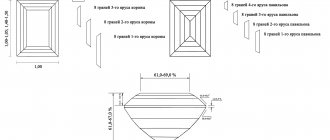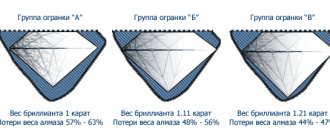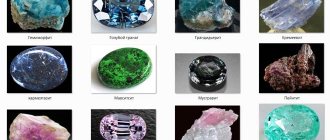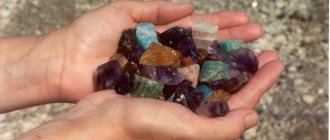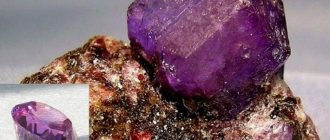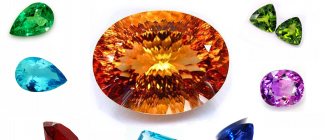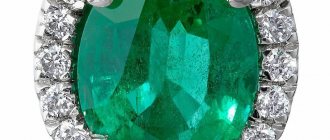Mined precious and semi-precious stones usually have an unattractive shape and are valued much lower than those that have been cut. It is this that allows you to convey all the beauty and uniqueness of a particular stone; it begins to sparkle and simply transforms.
Faceted stones are much more expensive, because this is a very complex and labor-intensive process that requires professionalism. There are many types of cuts, each of which has its own characteristics. Each stone is processed differently, depending on its characteristics.
Purpose of cutting
Cutting precious and semi-precious stones is a painstaking and time-consuming job. The main task of a jeweler is to obtain a perfect crystal from a nondescript piece of rock. To create a flawless stone, you must achieve the following goals:
- Use the edges to maximize the play of light.
- Maintain or increase color depth.
- Create the perfect shape.
It is possible to achieve the set goals only when the physical properties of a particular mineral are taken into account - hardness, fragility, purity, optical properties. These points influence the choice of cutting method, number of facets, emphasis on color preservation or the original mass of the nugget.
Octagon (emerald)
If the baguette looks like a rectangle from above, then the octagon or emerald cut looks like a trapezoid. It is also a stepped and convex shape, which demonstrates in all its beauty the beauty and transparency of the crystal.
It is somewhat inferior to the round cut or the “Princess” cut in its ability to play with refracted light, but surpasses them in the strength and brightness of the light flashes emitted.
Jewelry terminology
Before assessing the quality of the cut, you need to know some of the terms that craftsmen use when performing this type of processing of gems.
To enlarge the diagram, click on it.
Cutting a mineral involves dividing the material into the following zones:
- The platform or facet is the largest facet of the stone, the top flat base. The width of the pad is measured as a percentage of the total width of the nugget.
- The pavilion is the lower part of the stone.
- The girdle is the line separating the pavilion from the top of the gem. This boundary defines the perimeter of the stone. The girdle serves as a place for securing the faceted mineral in the setting of the product.
- The crown is the upper part of the stone, located above the girdle and surrounding the platform.
- The culet is the lowest point of a faceted nugget. Occasionally, a callet, as a cut element, is missing. Sometimes the absence of this part indicates damage to the mineral.
The cut edges are also called bevels. Depending on the type of cut, up to 240 facets are applied to one crystal. Each edge must be perfectly smooth and located at a specific angle. If the proportions are respected, it is ultimately possible to fully reveal the beauty of the mineral.
Pear (or drop)
Despite the name, with this cut the stone still looks more like a drop. Hence another name. Remember the famous drop earrings. This is exactly the same cut. In the form of small crystals, it can also be found in necklaces or rings.
Pear-shaped stones visually lengthen the neck when used in pendants or necklaces, or add grace to the fingers when used in a ring.
Cutting styles
The choice of stone processing technique depends on the type of mineral. For opaque nuggets, the cabochon technique or simply grinding is used. Transparent and translucent gems are cut using a faceted (or beveled) cut.
Also read: Jewelry with Emerald
Cabochon technique
Grinding is considered the most ancient style of mineral processing. To give a piece of rock an attractive shape, craftsmen cut off excess parts of the crystal and, using grinding, achieved a smooth, even, shiny surface. Today, this processing method, called “cabochon,” is applied to opaque or partially translucent gems.
The cabochon shape provides a convex surface, which favorably reflects the light flux. On the reverse side, the polished stones are flat. This style is particularly good at highlighting the beauty of cat's eye minerals or star stones that feature a rayed star design on the surface.
Faceted cut
To process precious and semi-precious gems, bevel cutting is used, which involves applying a certain number of flat edges to the surface of the stone. This type of processing provides several styles:
- Stepped. Using this style, craftsmen make side bevels in the shape of isosceles triangles or trapezoids. The stone platform has the shape of a polygon. The edges themselves, imitating steps, are applied one above the other. Step cutting also includes the table cutting technique, a simple variation that involves only two steps (bottom and top).
- Wedge-shaped. The technique involves a combination of triangular faces, creating tetrahedral pyramids with a trapezoidal base.
- Fantasy. This style combines two techniques - stepped and wedge-shaped.
Fancy cut shapes
Mixed (fancy) cutting is considered the most complex, requiring a high degree of professionalism from the master. The cost of such a stone will correspond to the work done. As a result, they get a gem that plays with all the colors and highlights in different lighting conditions.
Russian cut
This style stands apart among all kinds of gemstone processing techniques. The Russian cut, as an independent type, became known in those days when the Western world saw diamonds cut by Russian jewelers.
A distinctive feature of this style is the primacy of shape and symmetry, and not the preservation of the original mass of the mineral. Thus, Russian craftsmen mercilessly cut off the required amount of raw material, resulting in a flawlessly cut diamond without the slightest trace of polishing or scratches. This perfect style of processing is used everywhere today, and Russian-cut stones are considered the most expensive.
Why is briolette so valued?
Briolette cut stones are highly valued in the jewelry world due to their precision. The greater the number of facets, the more expensive the stone will be. If the stone is processed by a professional, this is immediately noticeable, because mistakes are unacceptable in briolette - they will be immediately visible on the surface - the edges will be uneven and the light passing through them will be distorted.
It’s not difficult to buy jewelry with this type of cut now, but you should immediately take into account their high cost. Earrings and pendants with similar stones look especially beautiful - they seem to float in the air due to the fact that they are not encased in metal.
If you want to purchase a truly original, exclusive piece of jewelry for an evening out that will match any outfit, you should consider briolette-cut jewelry.
Variety of varieties
Gemstone inserts in jewelry are replete with a variety of shapes. Trying to unlock the potential of this or that mineral, over the years craftsmen have come up with various methods of applying facets, creating masterpieces of familiar and unusual shapes.
Main types of cuts
Circle
This form was developed by jewelers at the dawn of the 20th century - the era when the first tools appeared that made it possible to process the hardest mineral on earth - diamond. The classic type of diamond cut involves the application of 57 facets - 24 facets are placed on the pavilion and 33 facets, including the platform, are applied to the crown. Some diamonds are cut more simply, using 17 or 33 facets. However, applying a smaller number of edges entails a significant loss of the original mass.
Circle
Emerald
This step-cut form got its name due to the elite, expensive gem. However, not only the mineral of the same name is processed with emerald cut, but also other nuggets that are large in size and have a high degree of transparency. The stone looks like a rectangle with beveled edges. “Emerald” does not provide diamond shine or shimmer, but it fascinates with bright flashes of light reflected from the surface of the stone.
Emerald
Oval
The oval shape became popular after the 50s of the twentieth century. Oval-shaped gems are cut using wedges, applying 57 facets, which gives the finished stone a bright shine and shimmer. Oval is best suited for rings, visually thinning women's fingers.
Oval
Marquis
The noble name reflects an elongated oval stone with pointed edges. It is believed that this name was given in honor of one of the favorites of the French King Louis XV - the Marquise de Pompadour. This person was famous for her passionate love of jewelry, as well as her charming smile. This option involves the application of 55 facets, the highlights of which resemble the smile of a marquise and look good in different types of jewelry.
Marquis
Pear
The outlines of the faces of pear-shaped crystals are similar to the Marquis type stones. Such gems are also shaped like a drop, the pointed end of which is fixed in the frame of the product. To obtain the “Pear” stone, craftsmen apply 55 or 56 facets. This gem is attractive in pendants or necklaces, as it visually lengthens the neck of the owner of the jewelry.
Pear
Heart
This form is considered the most feminine and romantic, as well as the most expensive. The labor-intensive cutting process requires compliance with the proportions of the width and length of the gem 1:1. The technology for creating “hearts” is reminiscent of cutting pear-shaped crystals.
Heart
Princess
These are crystals of square or rectangular shape, depending on which a different number of facets is applied - 49, 65 or 68. “Princess” has been used since the late 70s of the last century, finding application as an insert for wedding rings. In this case, the corners of the stone were necessarily fixed with a frame.
Princess
Baguette
This step-cut option is only suitable for minerals of impeccable quality, since the slightest flaws in the nugget are visible even without magnification. Nevertheless, the rectangular “Baguette” looks noble and respectable.
Baguette
Asher
The Asscher cut is similar to the emerald cut, but with more layers. Depending on the size of the raw material, the master applies from 25 facets, increasing the number of facets to 49, 72 or more for large gems. Gaining popularity in the 30s of the twentieth century, “Usher” still holds its position today.
Asher
Octagon
The octagon is a stepped octagon. The advantages of this variety are the revelation of the purity of the gem, the play of tints, as well as protection from all kinds of damage to the fragile nugget.
Octagon
Radiant
Radiant is the result of combining the Princess and Emerald cuts, revealing the color, brilliance and purity of the crystal. Such an octahedron is created from large-sized sources, often using ready-made inserts for men's jewelry.
Radiant
Briolette
One of the first forms of processing large elongated diamonds. To create “Briolette”, the gem is covered along its diameter with triangular edges, of which in the classic case there are 56 pieces. This method enhances the play of light highlights of the stone.
Briolette
Cushion
The cushion cut comes from the Baroque era. In the 17th – 18th centuries, European diamonds were cut with cushion cutting, since this technique implied maximum preservation of the weight of the original raw material. Another name for the form is “Antique”.
Cushion
Square
One of the forms of step cutting, providing the same length on all sides of the gem. Such inserts look better in bracelets.
Square
Trillion
Trillion
Execution technology
Indeed, the briolette cut is considered the most difficult. Now it is performed using special equipment and tools. First, the stone is inspected, marked, ground, and polished.
Optimization and planning of processing is carried out using computer technology, so the cutting process itself has indeed been significantly simplified.
The cut is modeled by computer, and the master then carries out the process itself, which takes quite a lot of time, but it all depends on the size of the stone. A professional master can perform a briolette cut on no more than 7-8 stones per day, while another cut can be done much faster.
Baguette
Types of step-type gemstone cuts include rectangular cutting - baguette. Essentially, it is an indicator of quality, since it shows both the pros and cons of the stone. In inserts of this shape, internal defects or cutting errors can be seen with the naked eye. For this reason, when choosing such jewelry, it is advisable to pay attention to the quality of stone processing.
Square (or usher)
Similar to a baguette, but with equal sides. Often used as the centerpiece of a ring or earrings. Often the inlay of smaller crystals emphasizes and extols its beauty.
The cut was invented in Belgium in 1902 by the Asscher brothers and the first peak of its popularity came in the 1930s. The number of edges varies depending on the weight (read: size) of the stone. In terms of jewelry design, this type of cut is typical of Art Deco jewelry.
